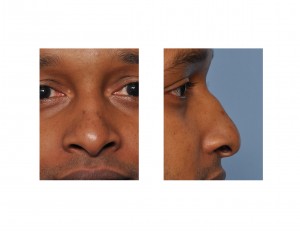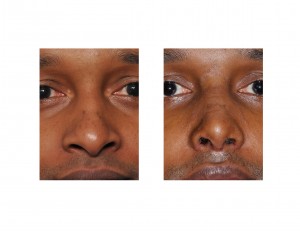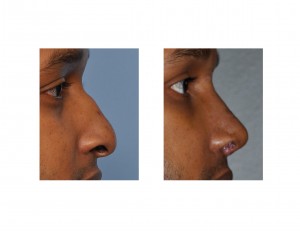Background: A common cosmetic operation in African-Americans is that of rhinoplasty. (nose reshaping) There is a dramatic difference in the nasal structure between that of this racial group and Caucasians. The nose shape is broader and flatter from the bridge down to the tip. This is a reflection of the underlying cartilage framework which lacks both projection and volume. Usually the cartilages are softer and less supportive as well. The changes that are planned must be harmonious to the face, however, and keep within some resemblence of their base ethnicity. Few patients want a ‘Michael Jackson’ nose which violated not only good facial balance but also pushed the envelope of what the tissues can tolerate. (trying to make too narrow of a nasal tip turned into a disaster)
One of the challenges in African-American rhinoplasty is the thick and oily skin that most patients have. This thick skin imposes several disadvantages including prolonged swelling after surgery and a limit as to how refined the nose can look. In general, a small delicate look to the nose in most African-American rhinoplasties can not be surgically created. It is also ill-advised to try and do so as well. One advantage to thick skin, however, is that any irregularities of the underlying bone and cartilage which has been manipulated will not be easily seen. This often provides little consolation to the patient who is hoping, however, for a more refined result.

Because of some prior orthognathic surgery (mandibular advancement) performed earlier in the year, he had a cephalometric x-ray and an old style xeroradiogram which showed beautifully how ‘underdeveloped’ his septal cartilage was. It became apparent that his hump was really only a pseudohump and only appeared as such because of the lack of septal height. At the tip area, the superior caudal septum was completely rounded off. This accounts for why the tip cartilages were not positioned on the apex of the septal cartilage and had essentially ‘slid off’ of the normal septal support. This anatomically also explains the flat and wide tip and relatively short columella with flared nostrils. (increased alar base width)


Case Highlights:
1) The African-American nose often has a pseudohump deformity which is created by a sagging and comparatively flat tip of the nose. The nostrils are flared as a result of the tip cartilage shape.
2) The use of computer imaging is extremely important to help the patient choose a final rhinoplasty result that is not ethnically incongruent with their aesthetic goals. The thick nasal skin will allow for prolonged swelling which the patient must anticipate.
3) Open rhinoplasty and cartilage grafting is critical to establish support for significant tip changes. The nasal dorsum usually needs cartilage addition, not reduction, to make for a better and more refined dorsal line.
|
|
|
|
Dr. Barry Eppley
Indianapolis Indiana


